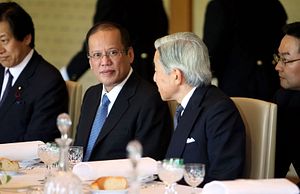President Benigno Aquino of the Philippines visited Japan from June 2-5. During his visit, he attended a dinner hosted by Emperor Akihito, delivered a speech at the Japanese Diet, and met Prime Minister Shinzo Abe and his cabinet.
His visit — and what came out of it — was a clear demonstration of the emerging security partnership between Japan and the Philippines. Following the summit, Abe and Aquino issued a joint statement in which they spelled out their shared interest in peace and stability in the Asia-Pacific region. The two leaders reiterated their shared belief that no country should be allowed to change the status quo by force or coercion. Japan and the Philippines also agreed to start negotiations toward an defense equipment transfer agreement, under which Japan would export defense equipment that will augment the capabilities of the Filipino coast guard.
Japan and the Philippines’ effort to strengthen their security partnership comes as anxiety over China’s increasingly aggressive behavior continues to grow among the countries in the Asia-Pacific region. At the annual Shangri-La Dialogue in Singapore between May 29-31, many countries, including the United States and Japan, expressed concern regarding China’s unilateral move to change the status quo in the South China Sea. The evolution of the Japan-Philippines relationship is a part of a trend in which U.S. allies and partners in the Asia-Pacific region — while still regarding a U.S. presence in the region as the anchor for the regional peace and stability — move to forge stronger relationships among themselves. Such renewed ties between Asian countries can amplify the United States’ existing alliances and partnerships in the region.
On the part of Japan, the evolution of its relationship with the Philippines is a critical component of its “proactive contribution for peace based on international cooperation” strategy. Since Tokyo established diplomatic relations with Manila in 1956, the Philippines has been the recipient of Japan’s Official Development Assistance (ODA) and other grass-roots assistance. Japan’s Self-Defense Forces (SDF) have rushed to help the Philippines whenever it has become the victim of a natural disaster, such as after the Haiyan Typhoon in 2013.
The new set of initiatives vis-à-vis the Philippines will build on the existing relationship and widen its scope. It will serve as an important example of how Tokyo can effectively utilize all of its policy tools to help the Philippines develop its indigenous capacity to respond to crises.
Furthermore, Japan’s outreach converges with Washington’s recent effort to revitalize its own alliance relations with Manila. When President Barack Obama visited the Philippines in April 2014 as a part of his Asian tour, the two countries announced a number of new initiatives, including the Enhanced Defense Cooperation Agreement under which U.S. forces gain temporary access to some military bases in the Philippines for the first time since the U.S. military’s departure from the country in 1992. Japan’s moves complement U.S. efforts to revamp its relationship with the Philippines and contribute to laying a foundation of a regional security architecture that effectively supplements the continuing U.S. presence in the region.
































